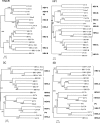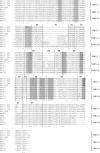Clinical features and complete genome characterization of a distinct human rhinovirus (HRV) genetic cluster, probably representing a previously undetected HRV species, HRV-C, associated with acute respiratory illness in children
- PMID: 17804649
- PMCID: PMC2168475
- DOI: 10.1128/JCM.01254-07
Clinical features and complete genome characterization of a distinct human rhinovirus (HRV) genetic cluster, probably representing a previously undetected HRV species, HRV-C, associated with acute respiratory illness in children
Abstract
Although human rhinoviruses (HRVs) are common causes of respiratory illness, their molecular epidemiology has been poorly investigated. Despite the recent findings of new HRV genotypes, their clinical disease spectrum and phylogenetic positions were not fully understood. In this study, 203 prospectively collected nasopharyngeal aspirates (NPAs), negative for common respiratory viruses (83 were human bocavirus [HBoV] positive and 120 HBoV negative), from hospitalized children during a 1-year period were subjected to reverse transcription-PCR for HRV. HRV was detected in 14 NPAs positive and 12 NPAs negative for HBoV. Upon VP4 gene analysis, 5 of these 26 HRV strains were found to belong to HRV-A while 21 belonged to a genetic clade probably representing a previously undetected HRV species, HRV-C, that is phylogenetically distinct from the two known HRV species, HRV-A and HRV-B. The VP4 sequences of these HRV-C strains were closely related to the newly identified HRV strains from the United States and Australia. Febrile wheeze or asthma was the most common presentation (76%) of HRV-C infection, which peaked in fall and winter. Complete genome sequencing of three HRV-C strains revealed that HRV-C represents an additional HRV species, with features distinct from HRV-A and HRV-B. Analysis of VP1 of HRV-C revealed major deletions in regions important for neutralization in other HRVs, which may be signs of a distinct species, while within-clade amino acid variation in potentially antigenic regions may indicate the existence of different serotypes among HRV-C strains. A newly identified HRV species, HRV-C, is circulating worldwide and is an important cause of febrile wheeze and asthmatic exacerbations in children requiring hospitalization.
Figures



References
Publication types
MeSH terms
LinkOut - more resources
Full Text Sources
Other Literature Sources

